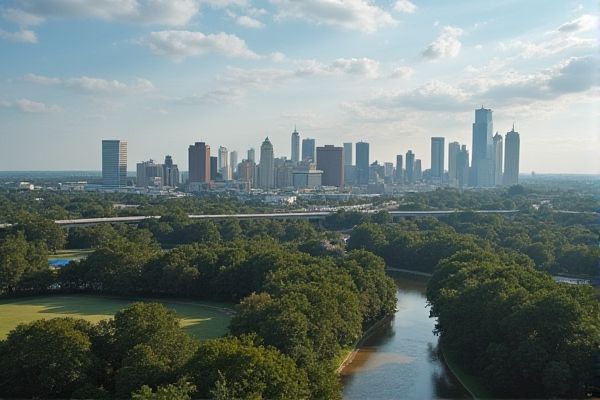
Weather and climate in Alabama: Humid subtropical climate. Hot, humid summers. Mild winters. Frequent thunderstorms. Risk of tornadoes. Rainfall year-round. Occasional snowfall. Gulf Coast hurricanes. High humidity levels. Variable seasonal temperatures.
Humid subtropical climate
Alabama's climate is classified as Humid Subtropical, characterized by hot, humid summers and mild winters, with year-round precipitation averaging 56 inches. The state's proximity to the Gulf of Mexico moderates temperatures, especially in the south, and influences the frequent thunderstorms and occasional tropical disturbances. For more detailed information on this topic, you can visit the Climate of Alabama page on Wikipedia.
Hot, humid summers
Alabama experiences hot, humid summers with average high temperatures often exceeding 90°F (32°C), particularly in areas like Montgomery and Tuscaloosa, which average 92°F (33°C) in July and August. The humidity is highest in southwest Alabama, and the summer heat is slightly tempered by winds from the Gulf of Mexico in the southern parts of the state. For more detailed information on Alabama's seasonal variations and weather patterns, you can visit the Climate of Alabama page on Wikipedia.
Mild winters
In Alabama, winters are generally mild, with average January temperatures ranging from 43°F (6°C) in the north to 52°F (11°C) in the south, and short cold spells are occasional but usually of short duration. The northern regions, such as Huntsville, can be slightly colder than the southern areas, like Mobile, but overall, winters remain relatively mild compared to other parts of the United States. For more detailed information, you can explore the climate specifics on Climates to Travel.
Frequent thunderstorms
Alabama experiences frequent thunderstorms throughout the year, with the Gulf Coast around Mobile Bay averaging numerous thunderstorm days annually. Eastern and northwest Alabama have fewer, though still significant, thunderstorm occurrences. These weather events are most common in the summer but can also be severe during spring and late autumn, often associated with destructive winds and tornadoes. To learn more about the Climate of Alabama, which is influenced by its geographical location, you can explore comprehensive data and analysis on various platforms.
Risk of tornadoes
In Alabama, the peak tornado season runs from March through May, with a secondary season in the fall, particularly in November and December. The state experiences a high number of tornadoes, especially in Mobile, Baldwin, and Jefferson counties, and is part of the tornado-prone region known as Dixie Alley. This region is notorious for its severe weather, posing significant challenges in terms of preparedness and insurance requirements for homeowners.
Rainfall year-round
Alabama experiences abundant rainfall year-round, with an average of 1,300-1,700 mm (51-56 inches) annually, depending on the region. The wettest seasons vary by area, with winter and spring being the wettest in the north, and summer in the south, due to thunderstorms and occasional hurricanes. For more detailed climate information, check out the Climate of Alabama page.
Occasional snowfall
Snowfall in Alabama is rare and varies significantly by region. Northern Alabama, particularly Huntsville, receives the most snow, with an average annual snowfall of 2.4 inches. In contrast, the Gulf Coast and Southern Alabama see virtually no snow, with most areas averaging less than 0.1 inches per year. For more detailed information, you can visit the Annual Snowfall in Alabama page to understand these regional differences better.
Gulf Coast hurricanes
Alabama is susceptible to hurricanes from June 1st to November 30th, with the most hurricane-prone areas being along the coastline, particularly in Mobile and Baldwin counties, due to their proximity to the Gulf of Mexico. The state experiences a significant number of tropical cyclones, with September being the most likely month for hurricane activity, and recent examples include Hurricane Sally and Hurricane Zeta, which caused substantial damage and flooding. For more information, you can visit the Emergency Response Guide to learn about preparedness and safety measures during hurricanes.
High humidity levels
Alabama experiences high humidity levels throughout the year, with daily average humidity ranging from 70% to 73% in different cities, and morning humidity often reaching as high as 84-86% while afternoon humidity can drop to around 52-56%. The state's humid subtropical climate, influenced by the Gulf of Mexico, contributes to the consistently high humidity, especially in the southern regions. For more detailed information about Alabama's humidity, visit the Current Results website.
Variable seasonal temperatures
Alabama experiences variable seasonal temperatures, with mild winters, where average minimum temperatures range from 29.3°F in the north to 39.9°F in the south, and hot, humid summers, where average maximum temperatures can reach up to 93°F in July. The state's temperature patterns are influenced by its mid-latitude location and the Gulf of Mexico, which leads to distinct seasonal variations and occasional extreme weather events like cold fronts and tornadoes. For more in-depth information, you can visit the Encyclopedia of Alabama to understand how these geographical factors impact the climate throughout the state.
